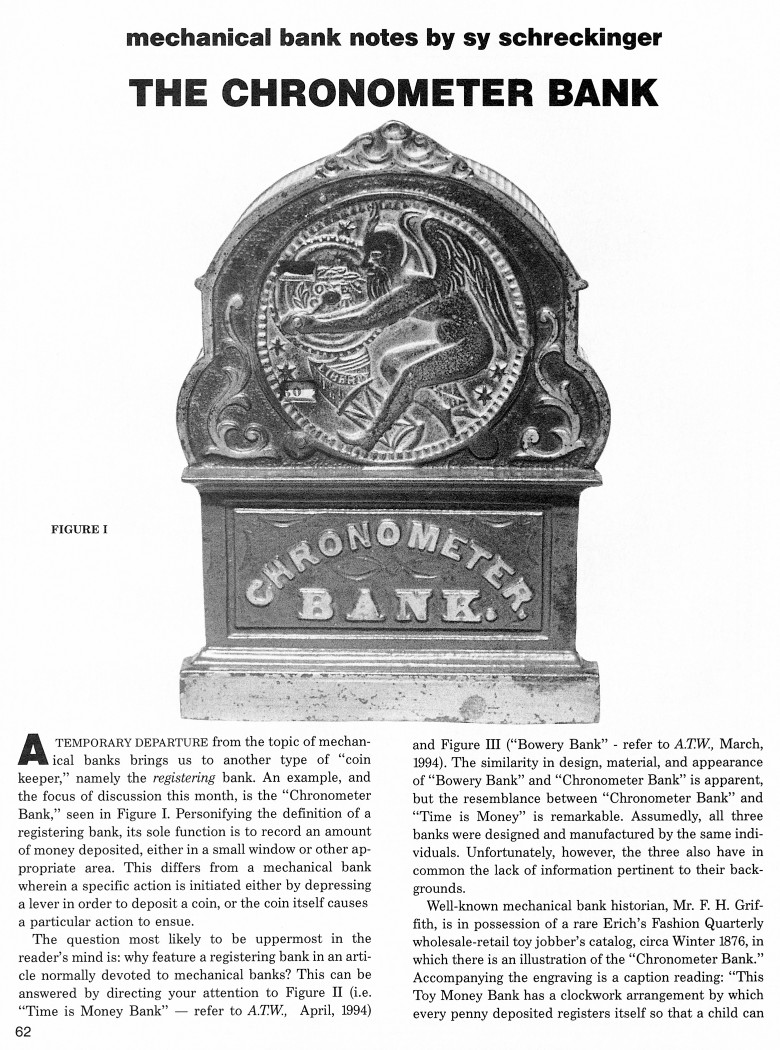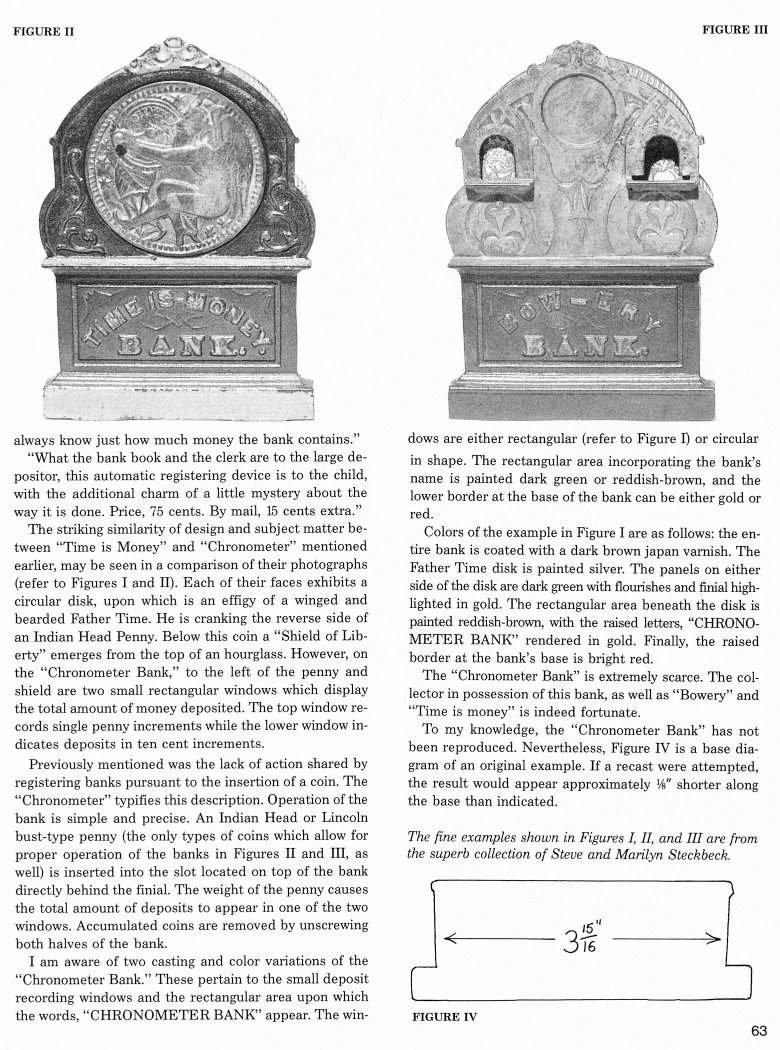|
The Chronometer Bank
by Sy Schreckinger – ANTIQUE TOY WORLD Magazine – May, 1994
A temporary departure from the topic of
mechanical banks brings us to another type of "coin keeper," namely the
registering bank. An example, and the focus of discussion this month, is
the "Chronometer Bank," seen in Figure I. Personifying the definition of a
registering bank, its sole function is to record an amount of money
deposited, either in a small window or other appropriate area. This
differs from a mechanical bank wherein a specific action is initiated
either by depressing a lever in order to deposit a coin, or the coin
itself causes a particular action to ensue.
The question most likely to be uppermost in the reader's mind is: why
feature a registering bank in an article normally devoted to mechanical
banks? This can be answered by directing your attention to Figure II (i.e.
"Time is Money Bank" — refer to A.T.W.,
April, 1994) Figure III ("Bowery
Bank" - refer to A.T.W.,
March, 1994). The similarity in design, material,
and appearance of "Bowery Bank" and "Chronometer Bank" is apparent, but
the resemblance between "Chronometer Bank" and "Time is Money" is
remarkable. Assumedly, all three banks were designed and manufactured by
the same individuals. Unfortunately, however, the three also have in
common the lack of information pertinent to their backgrounds.
Well-known mechanical bank historian, Mr. F. H. Griffith, is in
possession of a rare Erich's Fashion Quarterly wholesale-retail toy
jobber's catalog, circa Winter 1876, in which there is an illustration of
the "Chronometer Bank." Accompanying the engraving is a caption reading:
"This Toy Money Bank has a clockwork arrangement by which every penny
deposited registers itself so that a child can always know just how much
money the bank contains."
"What the bank book and the clerk are to the large depositor, this
automatic registering device is to the child, with the additional charm of
a little mystery about the way it is done. Price, 75 cents. By mail, 15
cents extra."
The striking similarity of design and subject matter between "Time
is Money" and "Chronometer" mentioned earlier, may be seen in a comparison
of their photographs (refer to Figures I and II). Each of their faces
exhibits a circular disk, upon which is an effigy of a winged and bearded
Father Time. He is cranking the reverse side of an Indian Head Penny.
Below this coin a "Shield of Liberty" emerges from the top of an
hourglass. However, on the "Chronometer Bank," to the left of the penny
and shield are two small rectangular windows which display the total
amount of money deposited. The top window records single penny increments
while the lower window indicates deposits in ten cent increments.
Previously mentioned was the lack of action shared by registering
banks pursuant to the insertion of a coin. The "Chronometer" typifies this
description. Operation of the bank is simple and precise. An Indian Head
or Lincoln bust-type penny (the only types of coins which allow for proper
operation of the banks in Figures II and 111, as well) is inserted into
the slot located on top of the bank directly behind the finial. The weight
of the penny causes the total amount of deposits to appear in one of the
two windows. Accumulated coins are removed by unscrewing both halves of
the bank.
I am aware of two casting and color variations of the "Chronometer
Bank." These pertain to the small deposit recording windows and the
rectangular area upon which the words, "CHRONOMETER BANK" appear. The
windows are either rectangular (refer to Figure I) or circular in shape.
The rectangular area incorporating the bank's name is painted dark green
or reddish-brown, and the lower border at the base of the bank can be
either gold or red.
Colors of the example in Figure I are as follows: the entire bank is
coated with a dark brown japan varnish. The Father Time disk is painted
silver. The panels on either side of the disk are dark green with
flourishes and finial highlighted in gold. The rectangular area beneath
the disk is painted reddish-brown, with the raised letters, "CHRONOMETER
BANK" rendered in gold. Finally, the raised border at the bank's base is
bright red.
The "Chronometer Bank" is extremely scarce. The collector in
possession of this bank, as well as "Bowery" and "Time is money" is indeed
fortunate.
To my knowledge, the "Chronometer Bank" has not been reproduced.
Nevertheless, Figure IV is a base diagram of an original example. If a
recast were attempted, the result would appear approximately 1/8" shorter
along the base than indicated.
The fine examples shown in Figures I, II, and III are from the superb
collection of Steve and Marilyn Steckbeck.
|


